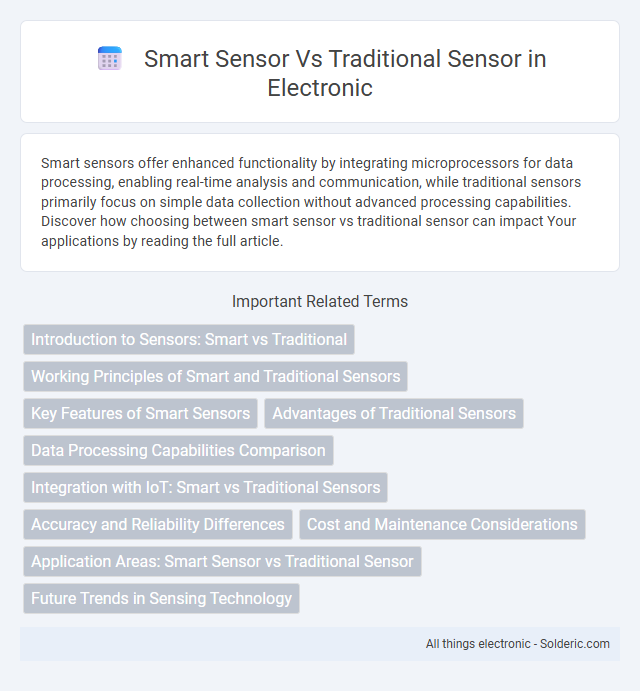Smart sensors offer enhanced functionality by integrating microprocessors for data processing, enabling real-time analysis and communication, while traditional sensors primarily focus on simple data collection without advanced processing capabilities. Discover how choosing between smart sensor vs traditional sensor can impact Your applications by reading the full article.
Comparison Table
| Feature | Smart Sensor | Traditional Sensor |
|---|---|---|
| Data Processing | Embedded processing capabilities | Requires external processing unit |
| Communication | Integrated wireless or wired communication | No built-in communication; manual data retrieval |
| Accuracy | High precision with self-calibration | Standard accuracy; requires manual calibration |
| Power Consumption | Optimized for low power usage | Variable, generally higher power usage |
| Functionality | Multi-functional: sensing, processing, communication | Single function: sensing only |
| Flexibility | Programmable and adaptable to conditions | Fixed functionality |
| Cost | Higher initial cost due to advanced tech | Lower cost, simpler design |
| Applications | IoT, automation, smart environments | Basic measurement tasks |
Introduction to Sensors: Smart vs Traditional
Smart sensors integrate microprocessors to process data in real-time, enhancing accuracy and enabling predictive maintenance, whereas traditional sensors solely capture raw data for external processing. These intelligent devices improve system efficiency by filtering noise and executing preliminary analytics locally. Traditional sensors, while cost-effective and simpler, often require extensive manual calibration and lack autonomous decision-making capabilities.
Working Principles of Smart and Traditional Sensors
Traditional sensors operate by detecting physical changes and converting them into electrical signals through basic mechanisms like resistive, capacitive, or inductive effects. Smart sensors integrate these conventional sensing elements with microprocessors to process data internally, enabling features such as signal conditioning, self-calibration, and communication capabilities. You benefit from smart sensors' ability to deliver accurate, real-time information with minimal external processing, unlike traditional sensors that rely heavily on external systems for data interpretation.
Key Features of Smart Sensors
Smart sensors integrate sensing elements with processing capabilities, enabling real-time data analysis and enhanced accuracy compared to traditional sensors. They often include built-in calibration, self-diagnostics, and wireless communication, facilitating seamless integration into IoT networks. The ability to process data locally reduces response time and power consumption, making smart sensors ideal for dynamic and complex environments.
Advantages of Traditional Sensors
Traditional sensors offer robust reliability due to their simple design and proven technology, making them highly durable in harsh environments. They require less power and maintenance, resulting in lower long-term operational costs compared to complex smart sensors. Your choice of traditional sensors ensures straightforward data readings without the need for advanced processing or connectivity, which can be advantageous in applications where simplicity and cost-efficiency are priorities.
Data Processing Capabilities Comparison
Smart sensors integrate advanced microprocessors enabling real-time data processing, filtering, and analysis directly within the device, reducing latency and improving decision-making speed. Traditional sensors primarily collect raw data, relying on external systems for processing and interpretation, which can lead to slower response times and increased bandwidth usage. Choosing smart sensors enhances Your system's efficiency by minimizing data transmission needs and enabling immediate, context-aware insights.
Integration with IoT: Smart vs Traditional Sensors
Smart sensors feature built-in processing capabilities and communication modules that enable seamless integration with IoT networks, facilitating real-time data analytics and remote management. Traditional sensors rely on external devices for data processing and lack direct connectivity, limiting their effectiveness in IoT ecosystems. The advanced integration of smart sensors enhances automation, predictive maintenance, and efficient resource management within connected environments.
Accuracy and Reliability Differences
Smart sensors offer enhanced accuracy by integrating advanced signal processing and real-time calibration, reducing measurement errors compared to traditional sensors. Their reliability is increased through self-diagnostic features and adaptive algorithms that ensure consistent performance under varying environmental conditions. You benefit from improved data precision and reduced maintenance needs, making smart sensors ideal for critical applications requiring high trustworthiness.
Cost and Maintenance Considerations
Smart sensors typically have higher initial costs due to advanced technology integration and connectivity features, but they reduce long-term expenses through predictive maintenance and remote monitoring capabilities. Traditional sensors are generally less expensive upfront but require more frequent manual maintenance and calibration, leading to increased operational costs over time. The ability of smart sensors to provide real-time data analytics minimizes downtime and extends equipment lifespan, offering significant cost savings in large-scale or critical applications.
Application Areas: Smart Sensor vs Traditional Sensor
Smart sensors excel in application areas requiring real-time data processing and adaptive responses, such as industrial automation, healthcare monitoring, and environmental sensing. Traditional sensors find more use in basic measurement tasks with minimal processing needs, including temperature monitoring, pressure measurement, and simple motion detection. The integration capabilities of smart sensors enable advanced functionalities in IoT ecosystems, while traditional sensors serve foundational roles in legacy systems.
Future Trends in Sensing Technology
Smart sensors integrate advanced data processing and wireless connectivity, enabling real-time analytics and adaptive responses, which traditional sensors lack. Future trends emphasize IoT integration, AI-driven data interpretation, and enhanced miniaturization for widespread deployment across industries. These innovations promise improved accuracy, energy efficiency, and predictive maintenance capabilities, revolutionizing sensing technology applications.
smart sensor vs traditional sensor Infographic

 solderic.com
solderic.com